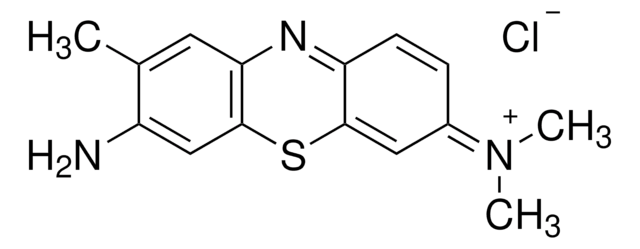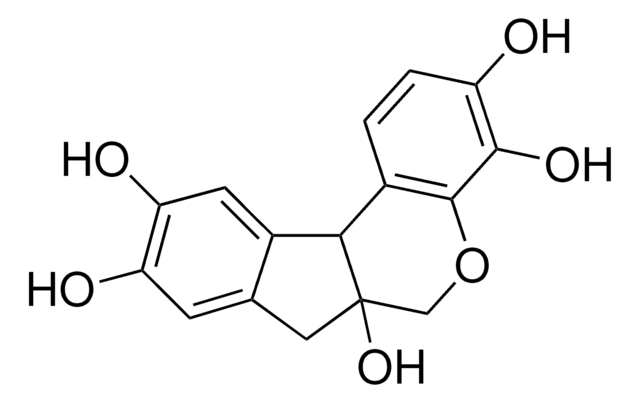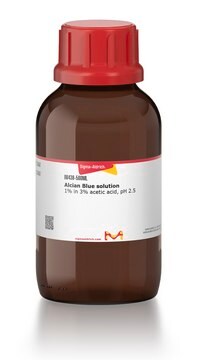89640
Toluidine Blue
8.74% (ZN (THEORY)), for microscopy (Hist., Vit.)
Sinônimo(s):
Tolonium chloride; Basic Blue 17
About This Item
Produtos recomendados
grau
for microscopy (Hist., Vit.)
Nível de qualidade
Ensaio
8.74% (ZN (THEORY))
Formulário
powder or crystals
técnica(s)
microbe id | staining: suitable
cor
green to very dark green
solubilidade
methanol: 0.01 g/10 mL, blue to very deep blue
εmax
≥800 at 621-636 nm in water
adequação
suitable for microscopy
aplicação(ões)
diagnostic assay manufacturing
hematology
histology
temperatura de armazenamento
room temp
cadeia de caracteres SMILES
[Cl-].[Cl-].Cl[Zn]Cl.Cc1cc2N=C3C=CC(\C=C3Sc2cc1N)=[N+](\C)C.Cc4cc5N=C6C=CC(\C=C6Sc5cc4N)=[N+](\C)C
InChI
1S/2C15H15N3S.4ClH.Zn/c2*1-9-6-13-15(8-11(9)16)19-14-7-10(18(2)3)4-5-12(14)17-13;;;;;/h2*4-8,16H,1-3H3;4*1H;/q;;;;;;+2/p-2
chave InChI
DAQXTSXITPUGRG-UHFFFAOYSA-L
Descrição geral
Aplicação
- to demonstrate amyloid; DNA in plant material, mast cells, Nissl substance, nuclei, and sulfatides
- in metachromatic staining of sulfated mucins and related materials
- as staining agent to identify the development and accumulation of the cartilage matrix, proteoglycans for isolation and culture of mesenchymal stem cells from mouse compact bone.
- staining of mucins in water-miscible resins and of nucleic acids in epoxy resins(1)
Ações bioquímicas/fisiológicas
Código de classe de armazenamento
11 - Combustible Solids
Classe de risco de água (WGK)
WGK 3
Ponto de fulgor (°F)
Not applicable
Ponto de fulgor (°C)
Not applicable
Equipamento de proteção individual
Eyeshields, Gloves, type N95 (US)
Escolha uma das versões mais recentes:
Já possui este produto?
Encontre a documentação dos produtos que você adquiriu recentemente na biblioteca de documentos.
Os clientes também visualizaram
Nossa equipe de cientistas tem experiência em todas as áreas de pesquisa, incluindo Life Sciences, ciência de materiais, síntese química, cromatografia, química analítica e muitas outras.
Entre em contato com a assistência técnica








